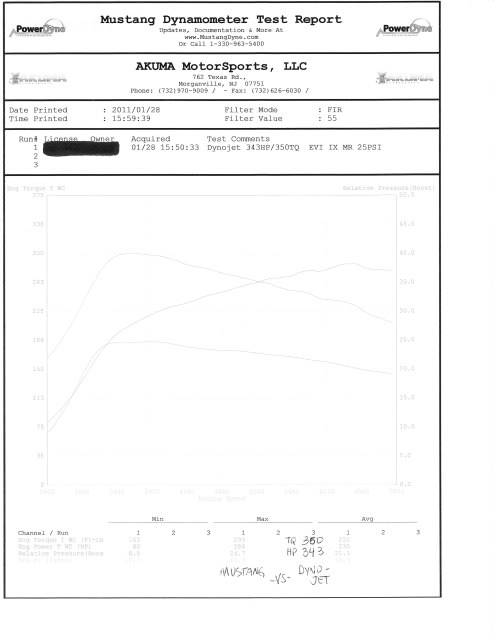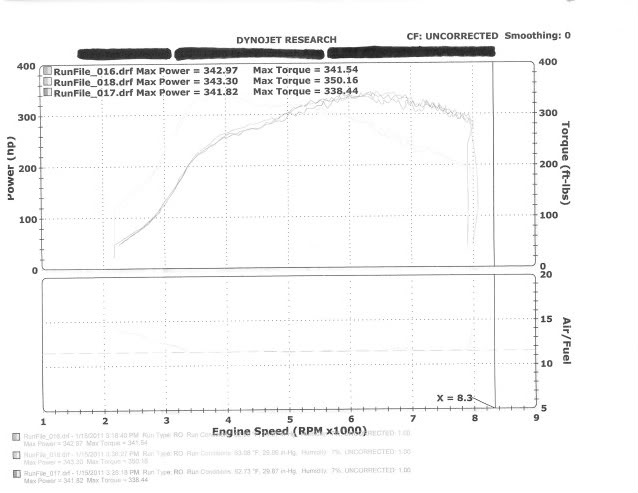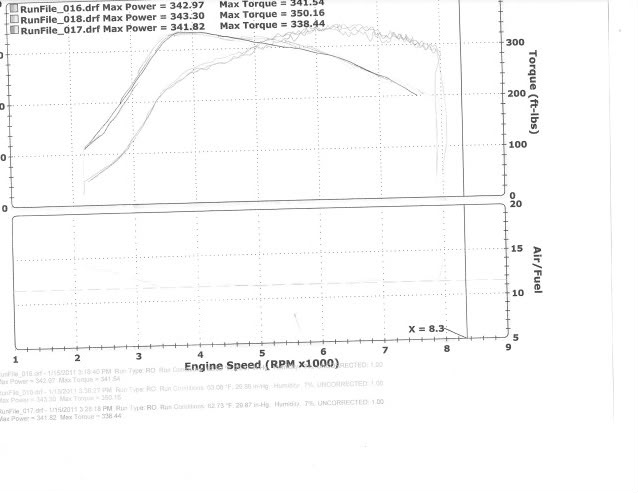Mustang vs DynoJet comparo
#1
Former Sponsor
Thread Starter
Join Date: Jan 2011
Location: Tri State
Posts: 420
Likes: 0
Received 0 Likes
on
0 Posts
Mustang vs DynoJet comparo
We had an opportunity to dyno an EVO MR 2006 that was just dynoed at a popular local Dynojet. We always new the numbers were lower, but it is hard to quantify the difference without back to back tests. This customer was tuned at the Dyno Jet, then was hee to pick up some parts. I offered to do a few pulls free of charge to see the numbers from one dyno to another. This NOT a tuner or shop comparison. It is ONLY a dyno comparison for the community to have a point of reference. I found the numbers to be quite interesting.
There is a few things here to note(DYNOJET). The major differences in the two types of dynos are their principals of operation. A true inertia dyno (such as the Dynojet 224x or 248) uses large steel rollers that contain mass. This mass is fixed, it can never change, and for those that remember high school physics, Force = Mass x Acceleration. Since every Dynojet dyno on the face of the earth has a mass that has been precisely quantified using a proprietary process, and that value is stored in the dyno software for each dyno, not only are the horsepower numbers consistent every morning, noon and night, but each and every Dynojet is relative to one another.
Once that power has been measured(DYNOJET), there are two ways to look at it, corrected or uncorrected. Since every Dynojet dyno is equipped with electronics that measure the atmospheric pressure, temperature, and humidity, the results are able to be analyzed as a “corrected value”. This allows an “apples to apples” comparison when testing in regions that are at different altitudes, which affects the atmospheric pressure, and different temperature. Uncorrected would eliminate the factors and provide a more raw number. ***Use SAE Corrected for the value, the old STD Corrected will give high numbers and should not be evaluated**
Things to note on the electric type load chassis dynos”. These types (Mustang, Dyno Dymamics) of dynos utilize rollers that usually have very little mass, hence they’re not a true inertia chassis dyno. In order to present any type of physical load on the vehicle, there needs to be a PAU (power absorption unit). Typically this PAU is in the form of electrical coils that utilize eddy current technology (think of this as a big electric brake). These dynos rely on a Load Cell for measurement. For our purposes, the Mustang, has a method to calibrate this load cell for accurate measurement. Once the load cell(there is no need to calibrate this every day) is calibrated properly, the dyno operator must enter certain parameters about the test vehicle that determine the rate of acceleration the dyno will allow, and are ultimately directly responsible for the power and torque readings that are displayed on the graph. The Mustang software takes this a few steps further, but you get the idea for this write up.
The idea here is, you need to be sure you get all the data. Know what correction factor you are running...this applies to all dynos. Be sure the weather station is working correctly for the DJ and the MD, if applicable. Find out what vehicle weight and HP@50 is entered into the MD software for apples to apple results. Be sure you have you DJ on SAE CORR and ask to see tghe Mustang numbers from the run page..the WCF(with correction factor) and corrected numbers.
You can take it a step further, if you so choose. Now this suggestion I make very carefully, as not every tuner will appreciate a barrage of questions. You can get data like load/MAF scaling/Boost/etc to help qualify the data further.
So what should you take away from this?? Ask questions, understand the dyno is a tuning tool ONLY. Delta change from stock is what is important, not the actual number. Finally, enjoy the car, whatever the number, it should be fun to drive!
Cheers!
John
Akuma Motorsports Mustang dyno: 286whp/299wtq

DynoJet dyno: 343whp/350wtq
Torque line is very faint...I will trace over and get another pic up for you guys.

Dyno sheet after tracing the torque line for better visability:

There is a few things here to note(DYNOJET). The major differences in the two types of dynos are their principals of operation. A true inertia dyno (such as the Dynojet 224x or 248) uses large steel rollers that contain mass. This mass is fixed, it can never change, and for those that remember high school physics, Force = Mass x Acceleration. Since every Dynojet dyno on the face of the earth has a mass that has been precisely quantified using a proprietary process, and that value is stored in the dyno software for each dyno, not only are the horsepower numbers consistent every morning, noon and night, but each and every Dynojet is relative to one another.
Once that power has been measured(DYNOJET), there are two ways to look at it, corrected or uncorrected. Since every Dynojet dyno is equipped with electronics that measure the atmospheric pressure, temperature, and humidity, the results are able to be analyzed as a “corrected value”. This allows an “apples to apples” comparison when testing in regions that are at different altitudes, which affects the atmospheric pressure, and different temperature. Uncorrected would eliminate the factors and provide a more raw number. ***Use SAE Corrected for the value, the old STD Corrected will give high numbers and should not be evaluated**
Things to note on the electric type load chassis dynos”. These types (Mustang, Dyno Dymamics) of dynos utilize rollers that usually have very little mass, hence they’re not a true inertia chassis dyno. In order to present any type of physical load on the vehicle, there needs to be a PAU (power absorption unit). Typically this PAU is in the form of electrical coils that utilize eddy current technology (think of this as a big electric brake). These dynos rely on a Load Cell for measurement. For our purposes, the Mustang, has a method to calibrate this load cell for accurate measurement. Once the load cell(there is no need to calibrate this every day) is calibrated properly, the dyno operator must enter certain parameters about the test vehicle that determine the rate of acceleration the dyno will allow, and are ultimately directly responsible for the power and torque readings that are displayed on the graph. The Mustang software takes this a few steps further, but you get the idea for this write up.
The idea here is, you need to be sure you get all the data. Know what correction factor you are running...this applies to all dynos. Be sure the weather station is working correctly for the DJ and the MD, if applicable. Find out what vehicle weight and HP@50 is entered into the MD software for apples to apple results. Be sure you have you DJ on SAE CORR and ask to see tghe Mustang numbers from the run page..the WCF(with correction factor) and corrected numbers.
You can take it a step further, if you so choose. Now this suggestion I make very carefully, as not every tuner will appreciate a barrage of questions. You can get data like load/MAF scaling/Boost/etc to help qualify the data further.
So what should you take away from this?? Ask questions, understand the dyno is a tuning tool ONLY. Delta change from stock is what is important, not the actual number. Finally, enjoy the car, whatever the number, it should be fun to drive!
Cheers!
John
Akuma Motorsports Mustang dyno: 286whp/299wtq

DynoJet dyno: 343whp/350wtq
Torque line is very faint...I will trace over and get another pic up for you guys.

Dyno sheet after tracing the torque line for better visability:

Last edited by AkumaMotorsport; Mar 2, 2011 at 10:07 AM.
#5
Evolved Member
iTrader: (21)
Join Date: Jan 2005
Location: SoCal - Where pimpin aint easy
Posts: 950
Likes: 0
Received 0 Likes
on
0 Posts
Thank you for posting this! It's so frustrating seeing these dyno sheets without ANY correction, and nobody ever asks why. Of course a turbo'd car in 40 degree weather is going to make crazy power in comparison to 80 degree day. I assume that Dynapak is the same principle.
#6
Evolving Member
iTrader: (8)
Join Date: Jun 2005
Location: SF Bay Area, CA
Posts: 385
Likes: 0
Received 0 Likes
on
0 Posts
I've also had a Dynojet (RRE) vs mustang (GST) done. My numbers were:
Dynojet: 297whp/286wtq
Mustang: 268whp/266wtq
Thanks Akuma for the explanation on the differences in dynos. I always wondered what the differences were.
Dynojet: 297whp/286wtq
Mustang: 268whp/266wtq
Thanks Akuma for the explanation on the differences in dynos. I always wondered what the differences were.
Trending Topics
#10
Former Sponsor
Thread Starter
Join Date: Jan 2011
Location: Tri State
Posts: 420
Likes: 0
Received 0 Likes
on
0 Posts
No problem guys. I think it is our(the shop) responsibility to educate the community to the best of our ability. This is something that seems so simple on the surface, but can be a bit more complex upon further investigation.
I don't think this will solve the 'dyno controversy' but a little more info can't hurt.
Cheers!
John
I don't think this will solve the 'dyno controversy' but a little more info can't hurt.

Cheers!
John
#11
EvoM Guru
iTrader: (94)
I tested my car at RRE as well after I got tuned by Bryan @ GST and the differences were:
380whp/353wtq(GST MD)-weather for these pulls was in the 80's
431whp/407wtq(RRE Dynapak)-weather for these pulls was about 105 degrees
So from the great jump in temperature I assume the car would have made even more power in the same weather as when I dyno'd at GST

#12
Registered User
iTrader: (5)
Akuma, can you explain to us how heavier wheels impact dyno numbers? Obviously on a Dynapak it's not a factor. I would think on a Dynojet when you press the wheels against the roller, the combined mass of the wheel / rotor would cause some variations. But, is wheel mass less of a factor on eddy current dynos?
#13
Former Sponsor
iTrader: (9)
Join Date: Aug 2006
Location: West Chicago, IL
Posts: 651
Likes: 0
Received 0 Likes
on
0 Posts
Wow, thats a pretty wide spread on the numbers there. Definitely possible with all of the calibration parameters on the mustang. Our mustang dyno at AMS is exactly 8% lower than our dynojet.
#15
Former Sponsor
Thread Starter
Join Date: Jan 2011
Location: Tri State
Posts: 420
Likes: 0
Received 0 Likes
on
0 Posts
Regards.
John


